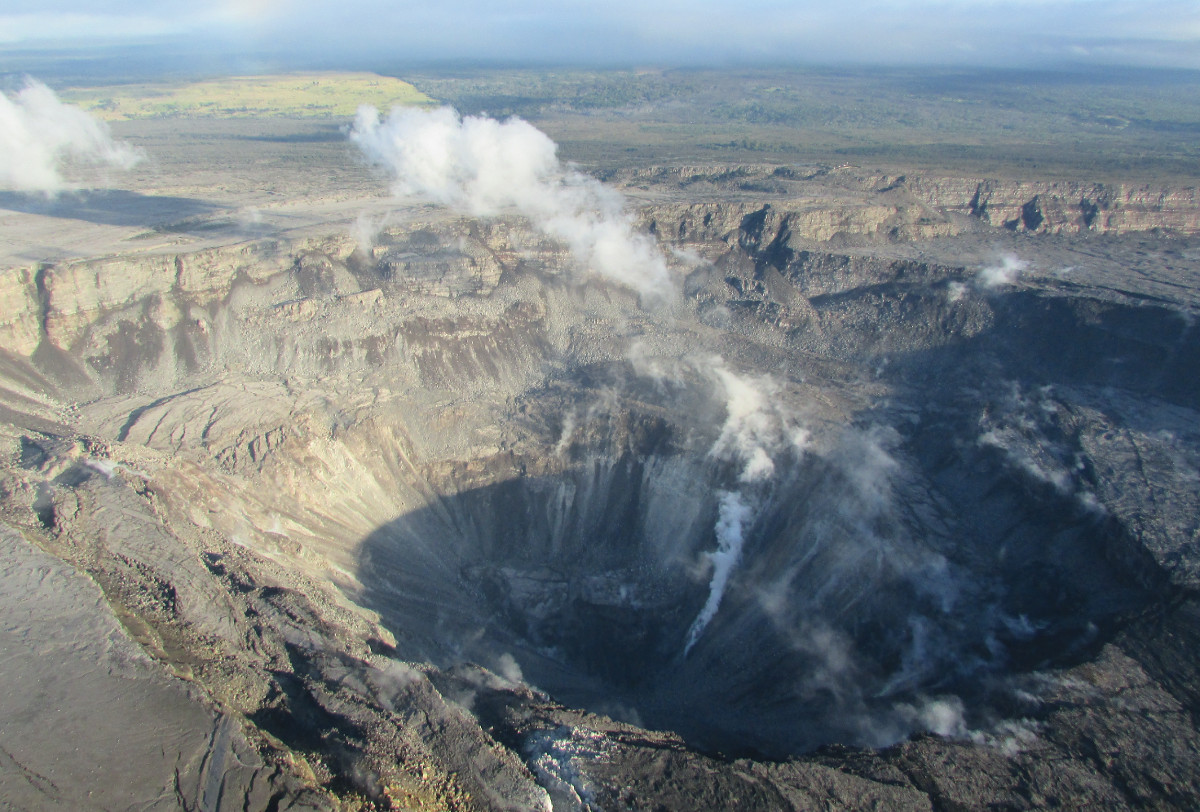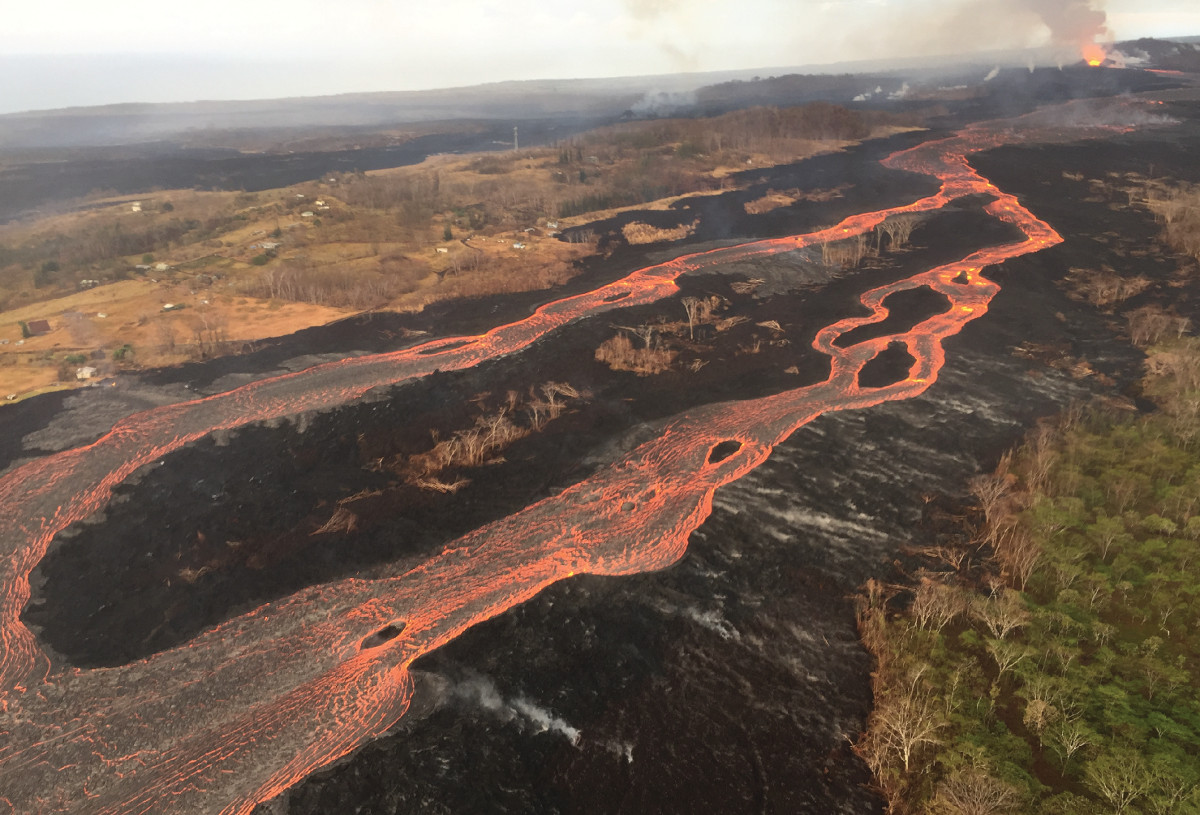
(USGS) Kīlauea Volcano’s 2018 summit collapse, shown here on July 28.
(BIVN) – For the 10th year, presentations about Hawaiian volcanoes will be offered around Hawai‘i Island throughout the month of January. The upcoming Volcano Awareness Month is the focus of this week’s Volcano Watch article, written by U.S. Geological Survey Hawaiian Volcano Observatory scientists and affiliates.
January 2019 marks the 10th annual “Volcano Awareness Month” on the Island of Hawaiʻi.
Launched in 2010 and held every year since, “Volcano Awareness Month” is one way that the USGS Hawaiian Volcano Observatory (HVO) promotes the importance of understanding the volcanoes on which we live. This past summer’s volcanic activity on Kīlauea—collapses within the summit caldera and a destructive lava flow on the lower East Rift Zone—certainly underscore the need for that understanding.
Neither Kīlauea nor Mauna Loa is currently erupting, but we must not become complacent during periods of relative quiet. Both are active volcanoes, and both will erupt again—although exactly when and where are unknowns at this point.
HVO continues to closely monitor Kīlauea and Mauna Loa and will inform emergency managers and the public if any significant change is detected.
HVO also encourages island residents to do their part by learning all they can about the volcanoes in their “backyards” and staying informed about each volcano’s status through HVO’s website. There, you can find weekly updates, monitoring data, and geologic histories for Kīlauea and Mauna Loa, as well as photos, frequently asked questions, and more.
As we have each year since 2010, HVO scientists and our colleagues at the University of Hawaiʻi at Hilo will help the learning process by offering a series of informative and engaging volcano presentations during the month of January. The complete Volcano Awareness Month schedule, including the date, time, location, and brief description for each talk, is posted on HVO’s website in the “HVO News” corner of the homepage.
For now, here’s a quick rundown of the January 2019 schedule:
The month begins with an “After Dark in the Park” program in Hawaiʻi Volcanoes National Park on January 8. That evening, an HVO geologist will recount the progression of Kīlauea Volcano’s dramatic lower East Rift Zone eruption this summer.
Additional “After Dark in the Park” programs will be offered by USGS scientists the following two weeks: on January 15, a discussion of new insights gained from Kīlauea’s 2018 eruption, and on January 22, a description of the collapse events within Kīlauea Volcano’s summit caldera. Each of these Park programs starts at 7:00 p.m. in the Kīlauea Visitor Center auditorium (National Park entrance fees may apply).
Given Kīlauea’s unprecedented activity in May‒August 2018, HVO scientists will also present overviews of what happened this summer, both on the lower East Rift Zone and at the summit of the volcano. These presentations, each covering the same information, will be offered on three different dates at various locations around the island.
On January 10, the first overview will be held on the UH-Hilo main campus in the University Classroom Building (UCB) Room 100 at 7:00 p.m. The next will be on January 16 in the Gates Performing Arts Center on the Hawaiʻi Preparatory Academy campus in Waimea, starting at 6:30 p.m. The third overview will be held on January 17 in the Kealakehe High School Cafeteria in Kailua-Kona, also at 6:30 p.m. Details about these three overviews are provided in the information posted on HVO’s website.
Hilo’s Lyman Museum will also host a volcano program in which a UHH/USGS geologist who helped monitor Kīlauea this summer will share his reflections and perspectives on the unfolding crises. His talk will be presented twice: on January 28 at 7:00 p.m., and on January 29 at 3:00 p.m. Admission is free to museum members; nonmembers pay a small fee. Details will soon be posted on the Lyman Museum website.
The final 2019 Volcano Awareness Month presentation will be held on January 31 in UCB Room 100 on the UH-Hilo main campus at 7:00 p.m. The director of UH-Hilo’s Spatial Data Analysis and Visualization Laboratory will describe the use of unmanned aerial systems (drones) to monitor Kīlauea’s lower East Rift Zone lava flow and will share imagery that his team collected this summer.
With two of the world’s most active volcanoes on the Island of Hawaiʻi, volcano awareness shouldn’t be limited to a single month. But January 2019 will be a good time to start or continue your quest to better understand Hawaiian volcanoes. Hope to see you at our talks!


by Big Island Video News5:30 pm
on at
STORY SUMMARY
HAWAIʻI ISLAND - January 2019 marks the 10th annual “Volcano Awareness Month” on the Island of Hawaiʻi, and the USGS Hawaiian Volcano Observatory will present a series of talks.